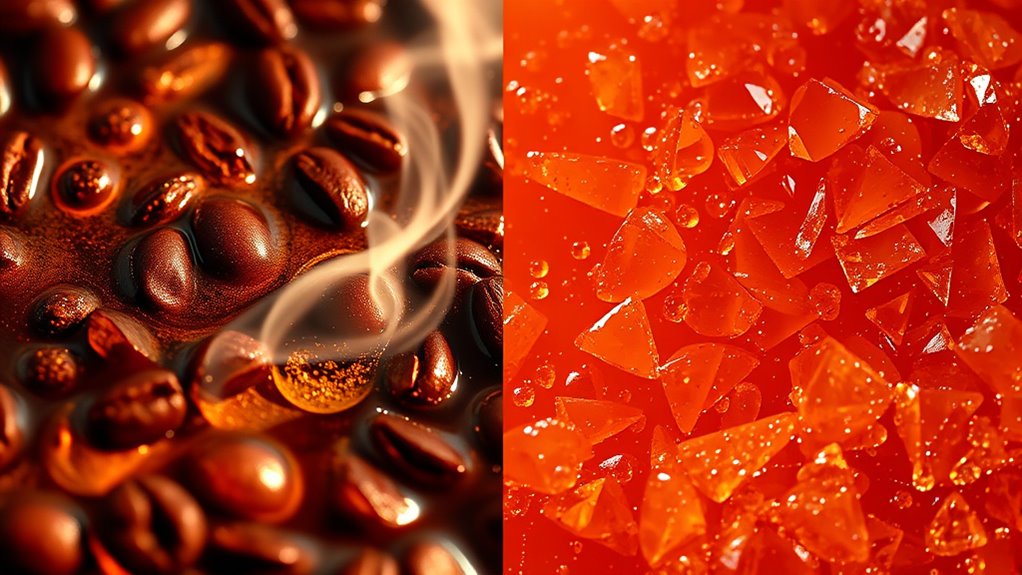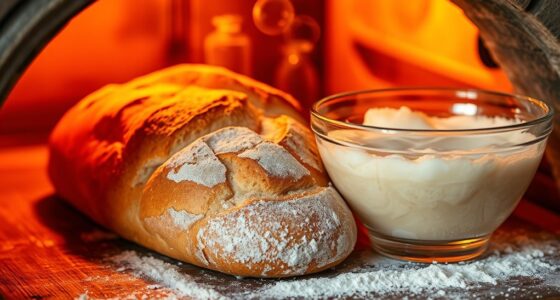In coffee roasting, the Maillard reaction occurs between 140°C and 165°C, where amino acids and sugars combine to create complex aromas, browns, and savory flavors. Caramelization kicks in around 170°C, breaking down sugars into sweet, toasty, and caramel notes. Both reactions shape coffee’s flavor, color, and aroma, with Maillard offering depth and caramelization adding sweetness. Continuing into the roasting process reveals how these chemical changes craft your perfect cup.
Key Takeaways
- Maillard reaction occurs between 140°C and 165°C, producing complex aroma compounds and browning through amino acids and sugars interaction.
- Caramelization starts around 170°C, involving sugar breakdown and crystallization, creating sweet, toasty flavors and darker hues.
- Maillard contributes savory, complex notes early in roasting; caramelization adds sweetness and depth in later stages.
- Precise temperature control influences the dominance of each reaction, shaping the coffee’s flavor profile and color.
- The balance of these reactions determines whether the coffee is bright and fruity or dark and smoky.
What Is the Maillard Reaction and How Does It Occur in Coffee Roasting
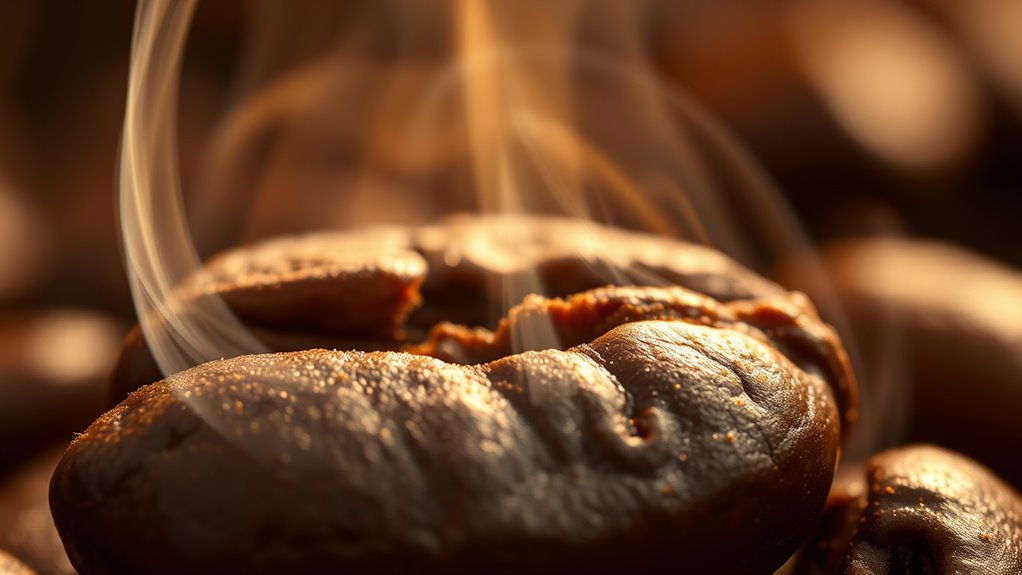
The Maillard reaction is a chemical process that gives roasted coffee its rich flavor and aroma. It occurs during roasting when amino acids and sugars in the coffee beans interact under heat. Your coffee bean genetics influence how readily these compounds react, affecting the depth of flavor development. As roasting progresses, the Maillard reaction produces complex molecules that contribute to aroma and taste. Additionally, regional differences in beans can influence how the Maillard reaction unfolds, impacting the final flavor profile. Your brewing techniques then reveal these flavors, highlighting the nuances created during roasting. Understanding how the Maillard reaction works helps you appreciate how different roasting levels or bean origins alter your coffee’s profile. By controlling variables like temperature and time, you can influence the extent of the Maillard reaction, tailoring each brew to your preferred flavor experience. Additionally, factors such as bean freshness and roasting environment can significantly impact the reaction’s efficiency and the final flavor. Moreover, advancements in machine learning algorithms are being utilized to analyze and optimize roasting profiles for consistency and flavor enhancement.
The Chemistry Behind Caramelization in Coffee Beans
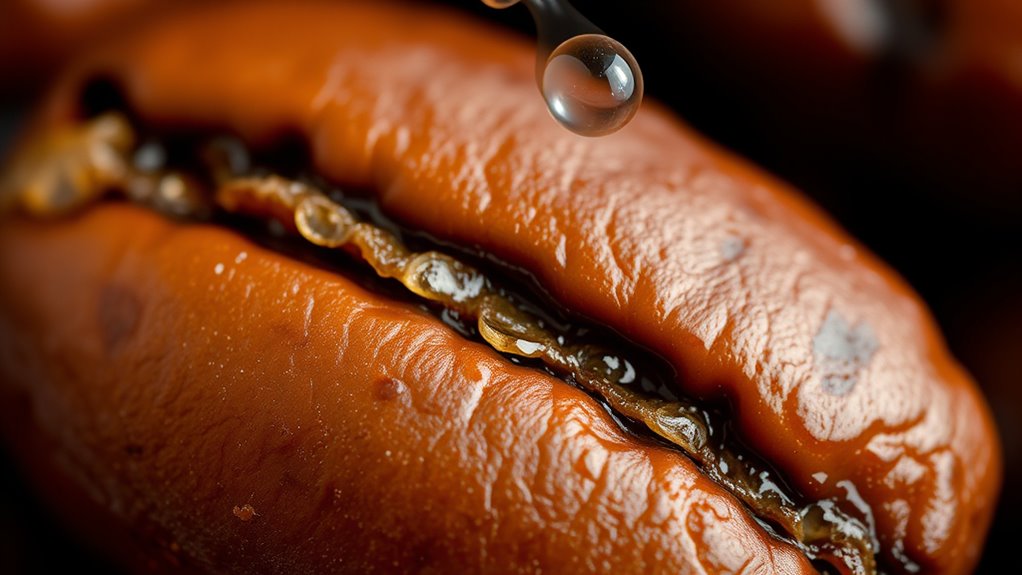
As coffee beans reach higher temperatures during roasting, caramelization begins to play a crucial role in developing their flavor and color. This process involves the thermal breakdown of sugars within the beans, creating new, complex compounds that add sweetness and depth. During roasting, coffee bean oxidation influences caramelization by affecting sugar stability and reaction rates. The dynamics within the roasting chamber—such as temperature fluctuations and airflow—also impact how evenly caramelization occurs, guaranteeing consistent flavor development. As the beans heat, sugars caramelize at around 320°F, producing rich, toasty notes. Effective control of roasting chamber conditions guarantees ideal caramelization, preventing over- or under-processing. Additionally, the application of advanced roasting technology can help optimize caramelization for unique flavor profiles. This chemical transformation contributes markedly to the coffee’s aroma, taste, and visual appeal, shaping the final profile of your brewed coffee. Understanding the chemical reactions involved allows roasters to fine-tune their process for superior quality and flavor complexity.
Key Differences Between Maillard Reaction and Caramelization
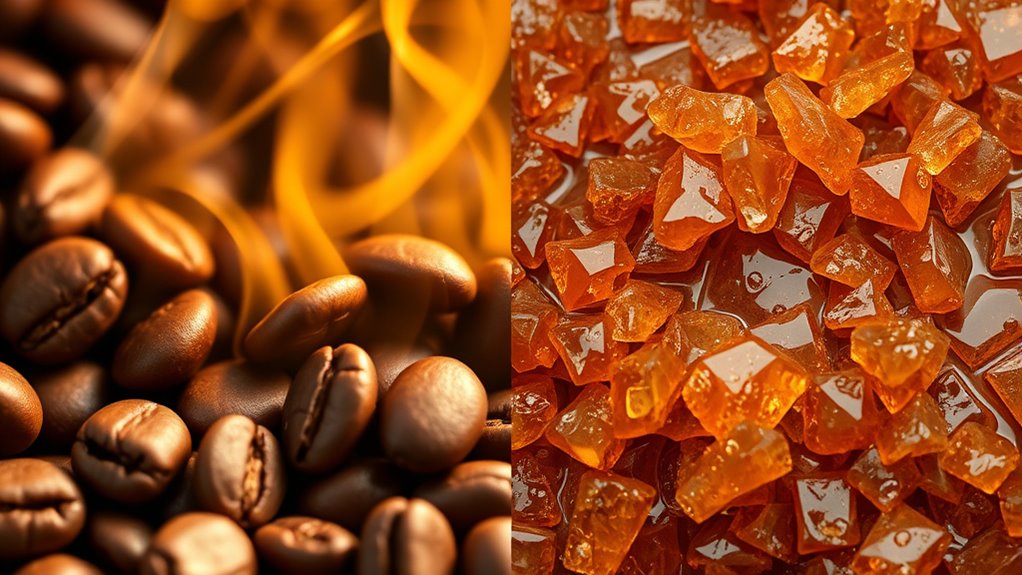
You’ll notice that the Maillard reaction and caramelization happen at different stages and temperatures during roasting. The Maillard reaction involves amino acids and sugars creating complex flavors early on, while caramelization focuses on sugar breakdown at higher temperatures. Understanding these differences helps you control flavor development and timing for the perfect roast. Additionally, controlling temperature fluctuations during roasting is crucial to influence which reaction dominates and to achieve the desired flavor profile. Precise temperature control allows roasters to optimize the balance between these two processes, enhancing the overall flavor complexity of the coffee.
Process Types and Stages
Understanding the differences between the Maillard reaction and caramelization is essential to grasp how coffee develops its flavor profile during roasting. These processes occur at different stages and influence bean color and flavor complexity. The Maillard reaction starts early, involving amino acids and sugars, producing complex flavors and browning the beans gradually. It typically occurs at lower temperatures, leading to a richer aroma and deeper color. Additionally, the Maillard reaction is a key contributor to flavor development in roasted coffee. This reaction also enhances the aroma profile, making the coffee more inviting and nuanced. Caramelization happens later, as sugars break down at higher temperatures, creating sweeter, more intense flavors and darker bean shades. While both processes contribute to overall flavor development, their timing and mechanisms differ. Recognizing these stages helps you control the roast to optimize flavor complexity, ensuring the beans reach the desired color and taste profile. On-device AI capabilities can assist roasters in monitoring these reactions in real time for better precision.
Flavor Compound Formation
The distinct chemical processes of the Maillard reaction and caramelization shape the flavor compounds that give roasted coffee its complexity. These reactions influence the aromatic profile, affecting brewing techniques and coffee certifications. Glycolic acid, a product of certain roasting reactions, can also impact the final flavor and texture of the coffee. 1. The Maillard reaction creates a variety of nitrogen-containing compounds, resulting in complex, savory flavors. 2. Caramelization produces sweet, caramel-like aromas, emphasizing sweetness in your brew. 3. The Maillard process contributes to the development of antioxidants, which can be highlighted in specialty certifications. 4. Caramelization intensifies color and sweetness, influencing how different roasting levels are perceived in brewing methods. Recognizing the specific chemical reactions involved allows roasters to fine-tune their profiles for desired flavor outcomes. Additionally, understanding the thermal processes during roasting helps optimize flavor development and consistency.
Understanding these differences helps you select beans and roast profiles aligned with specific brewing techniques and certification standards, ensuring a balanced flavor experience.
Temperature and Timing
Temperature and timing are critical factors that distinguish the Maillard reaction from caramelization during coffee roasting. The Maillard reaction occurs at lower temperatures and over a longer period, allowing for complex flavor development and nuanced aroma profiles. As you roast, maintaining precise timing ensures the desired level of flavor complexity without overdeveloping color. Controlling temperature is essential to prevent under or over-roasting, which can significantly impact flavor outcomes. Proper temperature management can also influence the chemical reactions that develop during roasting, impacting the final flavor profile. Additionally, understanding the reaction thresholds helps roasters optimize the process for desired results. Caramelization, on the other hand, requires higher temperatures and shorter durations, leading to rapid color development and sweet, caramel-like flavors. If you push the temperature too quickly, you’ll risk burning the beans and losing subtle notes. Proper control of temperature and timing helps you balance color and flavor, ensuring your roast achieves the ideal harmony between Maillard’s depth and caramelization’s sweetness.
The Role of Sugars and Amino Acids in Flavor Development
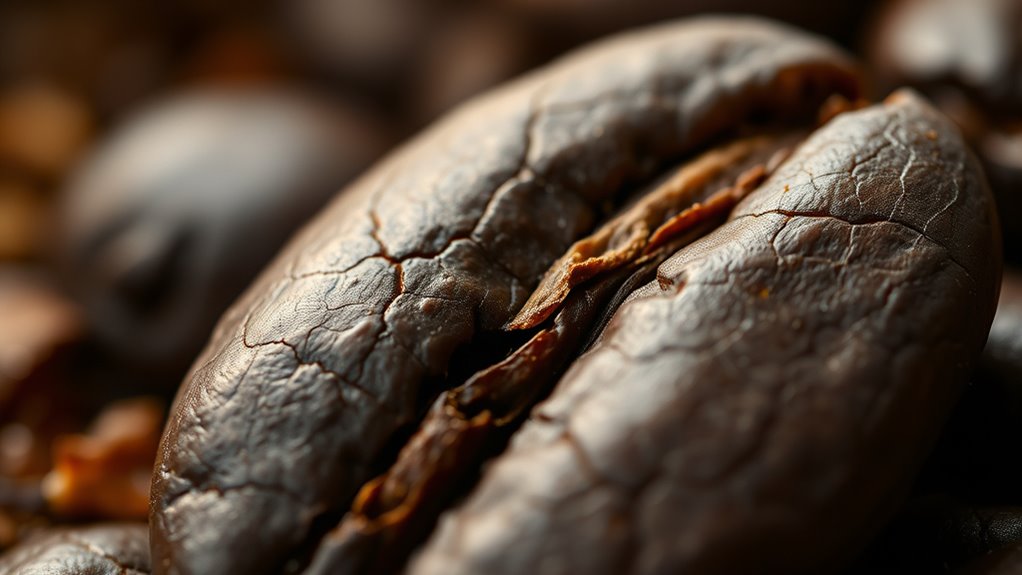
Sugars and amino acids are key players in shaping coffee’s complex flavors during roasting. Their interactions lead to a variety of aromatic compounds.
- As sugars break down, sugar crystallization occurs, forming caramel-like flavors.
- Amino acids undergo polymerization, creating melanoidins that add body and color.
- These compounds interact in Maillard reactions, producing rich, roasted aromas.
- The balance between sugar caramelization and amino acid reactions determines the coffee’s depth and complexity.
Your roasting process influences these reactions considerably. Controlling temperature and time affects how sugars and amino acids react, resulting in unique flavor profiles. Understanding their roles helps you craft coffee with desired aroma, body, and sweetness.
Temperature Thresholds for Each Reaction During Roasting
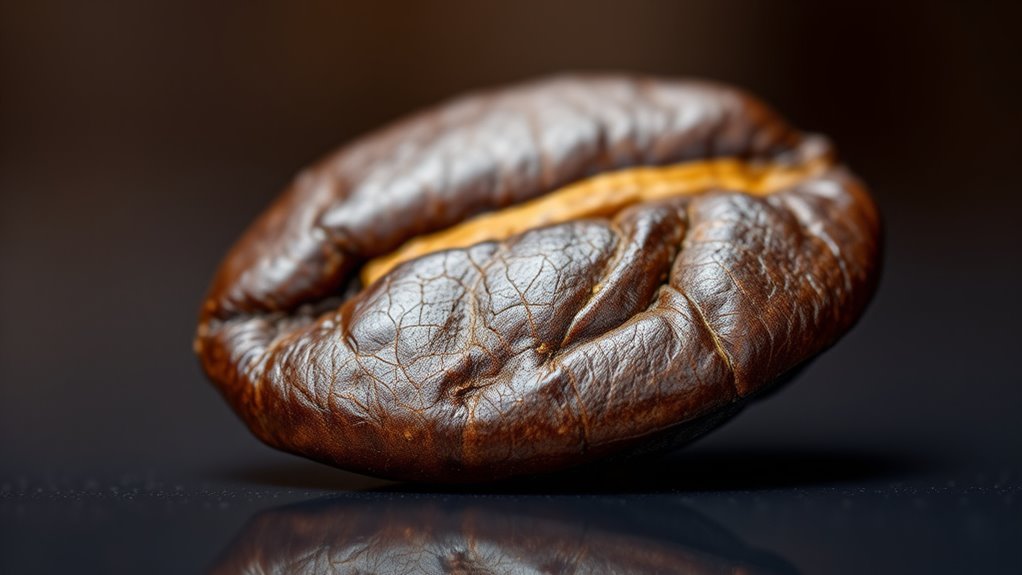
Understanding the temperature thresholds for key reactions helps you control coffee flavor development. The Maillard reaction typically occurs between 140°C and 165°C, creating complex aromas and browns. Research supports 16PF for predicting job performance; MBTI popular for personal development. The Maillard reaction is influenced by factors such as temperature control and moisture content, which can alter the final flavor profile. Caramelization starts around 160°C and continues up to 180°C, adding sweetness and body to your roast. [Validating through extensive research ensures reliability and accuracy.
Maillard Reaction Temperature
The Maillard reaction begins to occur during coffee roasting once the beans reach specific temperature thresholds, transforming amino acids and sugars into complex flavor compounds. This reaction kicks in around 140°C to 165°C, initiating chemical pathways that enhance flavor.
- You’ll notice the development of rich, roasted aromas as temperature increases.
- Flavor enhancement occurs through the formation of melanoidins, contributing to color and taste.
- The reaction’s intensity depends on precise temperature control, affecting the depth of flavor.
- Staying within the ideal temperature range ensures the chemical pathways produce desirable compounds without burning.
Understanding these temperature thresholds helps you control the Maillard reaction’s contribution to flavor, ensuring a balanced, nuanced roast that highlights the beans’ natural qualities.
Caramelization Temperature Range
As coffee beans reach temperatures around 170°C to 200°C, caramelization begins to occur, transforming sugars into rich, golden-brown compounds that deepen the flavor profile. This process, known as sugar browning, occurs within specific temperature thresholds where heat causes sugars to break down and form new molecules. Typically, caramelization happens between 170°C and 190°C, depending on the sugar type and roasting conditions. As you push past 200°C, the process intensifies, producing more complex flavors and darker hues. Understanding these temperature thresholds is essential for controlling the roast level and flavor development. HEPA filtration contributes markedly to the sweetness, body, and color of your coffee, making it a key step in roasting that shapes the final cup’s character. Additionally, precise temperature control during roasting influences the development of specific flavor notes, which are crucial for achieving the desired coffee profile. Moreover, controlling temperature precisely can help prevent undesirable flavors, ensuring a balanced and high-quality roast.
How These Reactions Influence Coffee’s Aroma and Taste Profiles

During coffee roasting, complex chemical reactions transform raw beans into aromatic and flavorful brews. These reactions directly influence your coffee’s aroma and taste profiles by creating flavor complexity and enhancing aroma. Here’s how:
During roasting, chemical reactions develop aroma and flavor, shaping your coffee’s unique taste profile.
- Maillard reactions produce a wide array of aromatic compounds, boosting aroma enhancement and adding depth.
- Caramelization creates sweet, caramel-like notes that enrich flavor complexity.
- Both processes generate volatile compounds that contribute to the coffee’s unique aroma profile.
- The balance of these reactions determines whether the coffee tastes smooth, sweet, or more bitter, shaping your sensory experience.
Visual and Chemical Changes in Beans During Maillard and Caramelization

When coffee beans are roasted, the Maillard reaction and caramelization cause noticeable visual and chemical changes that define the final flavor and aroma. These transformations depend heavily on bean genetics, which influence how heat triggers these reactions, and storage conditions, which impact the beans’ moisture and chemical composition. During Maillard browning, amino acids and sugars react, creating pigments and complex flavors visible as beans darken. Caramelization involves sugar breakdown, adding sweetness and color. Proper storage preserves bean quality, ensuring consistent chemical reactions during roasting. Visually, beans become darker and more uniform. Chemically, new compounds develop, contributing to aroma complexity and taste depth. Understanding these changes helps you optimize roasting to highlight the unique characteristics rooted in bean genetics and storage history.
Controlling Roasting Parameters to Optimize Flavor Formation
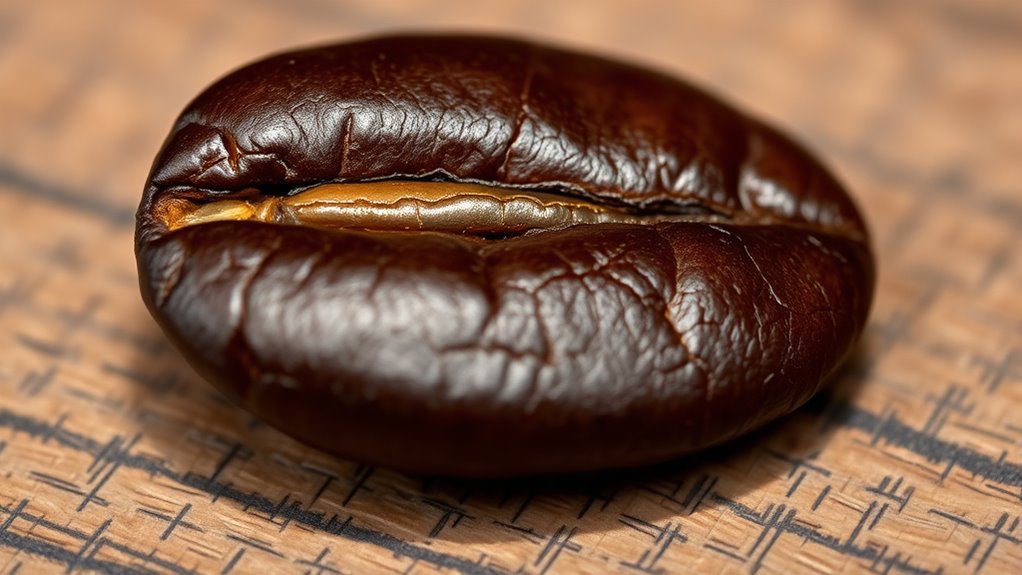
You can shape the flavor of your coffee by carefully managing roasting temperature and duration. Adjusting temperature strategies helps control the development of desirable chemical reactions, while timing influences the balance of sweetness and acidity. Mastering these parameters allows you to produce a consistent, flavorful roast every time.
Temperature Management Strategies
Controlling the temperature during roasting is essential for developing desirable coffee flavors. Precise temperature management ensures consistent bean development and flavor profile. To optimize this, consider these strategies:
- Monitor the roast curve closely to prevent overheating, which can cause uneven flavors.
- Use effective cooling techniques immediately after reaching the desired roast level to secure flavor and halt Maillard reactions.
- Maintain bean uniformity by agitating beans evenly, ensuring consistent heat distribution.
- Adjust heat application based on real-time temperature readings, avoiding rapid spikes that can lead to undesirable caramelization or underdeveloped flavors.
Implementing these strategies helps you achieve a balanced roast, enhancing complex flavor development and guaranteeing each batch meets quality standards. Proper temperature control is key to releasing the full potential of your coffee.
Roast Duration Effects
The duration of the roast considerably influences the development of coffee’s flavor profile, as it determines how long beans are exposed to heat and how chemical reactions progress. Longer roasts often enhance caramelization, producing sweeter, fuller-bodied coffees, while shorter roasts preserve brighter, fruity notes. To optimize flavor, you should carefully control roast duration, balancing Maillard and caramelization reactions. Sustainability practices and bean sourcing also play roles; beans sourced ethically and roasted with precision can improve flavor complexity. Extended roasting may require adjustments based on bean origin to avoid overdevelopment or underdevelopment. By monitoring roast duration closely, you ensure consistent quality while supporting sustainable sourcing practices that respect the beans’ origins. This approach helps you craft coffees that are flavorful, balanced, and aligned with eco-conscious values.
Impact of Reaction Timing on Final Coffee Quality

Timing during the roasting process plays a crucial role in shaping the final coffee’s flavor and aroma. If you control reaction timing carefully, you can achieve better flavor balance and maintain roast consistency. Here are key impacts:
- Early reactions influence brightness and acidity, shaping the coffee’s initial flavor profile.
- Mid-roast timing determines the development of sweetness and body.
- Late-stage reactions affect the depth of caramel notes and overall complexity.
- Over-roasting or rushing leads to uneven roast levels, compromising flavor balance and consistency.
Practical Examples of How These Reactions Affect Different Coffee Styles
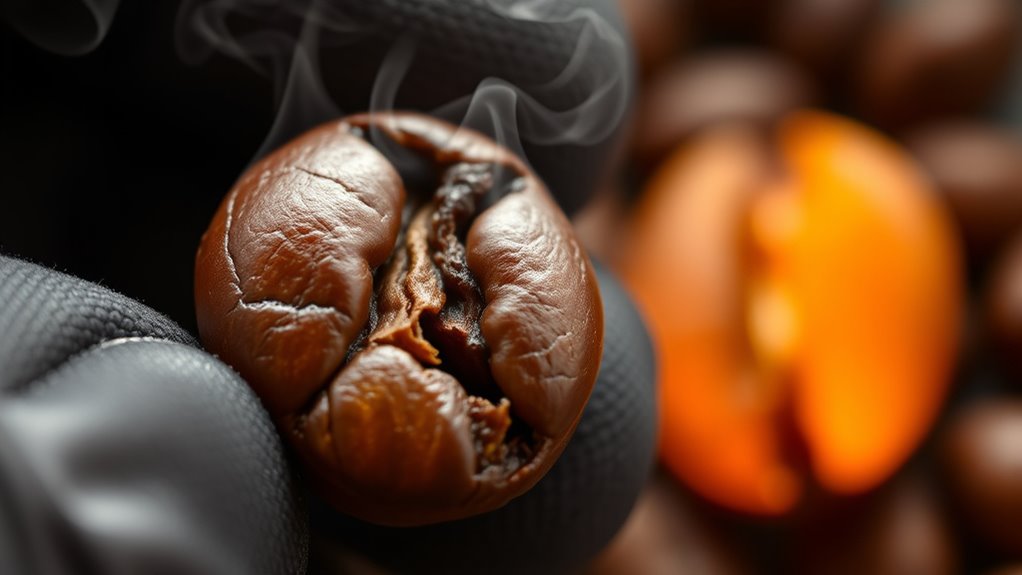
Different coffee styles showcase how reaction timing influences flavor development. Light roasts highlight the unique genetics of coffee beans, preserving bright, fruity, and floral notes shaped by their genetics. Here, Maillard reactions occur early, creating complex aromas without overpowering caramelization. Medium roasts balance Maillard and caramelization, resulting in richer, sweeter flavors, especially in beans with specific genetics suited for this profile. Dark roasts, often achieved with specialized roasting equipment, emphasize caramelization, producing bold, smoky flavors that mask origin nuances. Variations in roasting equipment also impact these reactions: drum roasters provide more uniform heat, enhancing consistent flavor development, while fluid-bed roasters allow for rapid, high-temperature reactions. By understanding these factors, you can craft distinct coffee styles that highlight different chemical reactions and bean characteristics.
Frequently Asked Questions
How Do Maillard and Caramelization Reactions Influence Coffee Shelf Life?
You might notice that Maillard and caramelization reactions impact coffee shelf life by affecting freshness and storage stability. These reactions cause flavor changes over time, often leading to staleness and loss of aroma. Proper storage slows down these processes, helping your coffee stay fresh longer. To maintain ideal flavor, keep your coffee in a cool, airtight container, minimizing exposure to oxygen, heat, and light that accelerate these reactions.
Can Roasting Techniques Selectively Enhance Either Maillard or Caramelization?
You can influence roasting techniques to selectively enhance either Maillard or caramelization through careful roasting parameter optimization. By adjusting temperature and time, you steer the reactions: higher temperatures and shorter times favor caramelization, while moderate temperatures with extended roasting promote Maillard reactions. This selective reaction enhancement lets you craft flavor profiles to your preference, emphasizing sweetness and complexity or richness and color, depending on your desired outcome.
Are There Specific Bean Varieties More Prone to One Reaction Over the Other?
Coincidences often reveal hidden preferences, much like how bean varietal influence shapes reaction propensity. You’ll find that certain beans, like Arabica, tend to favor Maillard reactions for their complex flavors, while Robusta beans lean toward caramelization, producing sweeter notes. Recognizing these tendencies allows you to tailor roasting techniques, emphasizing specific reactions to enhance your desired flavor profile based on the bean’s innate characteristics.
How Do Altitude and Climate Affect These Chemical Reactions During Roasting?
Altitude effects and climate influence how your coffee beans roast. Higher altitudes often lead to beans with denser structures, affecting heat transfer and promoting Maillard reactions. Cooler, humid climates can slow caramelization, resulting in different flavor profiles. You’ll notice that beans from varied environments develop unique tastes because these factors alter the chemical reactions during roasting. Understanding these influences helps you control the process and craft your ideal coffee.
What Are the Health Implications of Compounds Formed by These Reactions?
You might not realize it, but compounds from Maillard reactions and caramelization can impact your health. Some may pose health risks if consumed in excess, like acrylamide, linked to cancer risks. However, many of these compounds also have antioxidant properties that could protect your cells. Understanding this balance helps you enjoy coffee responsibly, knowing it offers both potential health benefits and risks based on how it’s processed.
Conclusion
By understanding the dance between Maillard reactions and caramelization, you hold the key to opening rich, complex coffee flavors. Think of these reactions as the orchestra behind each brew, shaping aroma and taste with every degree of heat. Mastering their interplay allows you to fine-tune your roast, transforming simple beans into a symphony of delightful sensations that captivate the senses and elevate your coffee experience.
